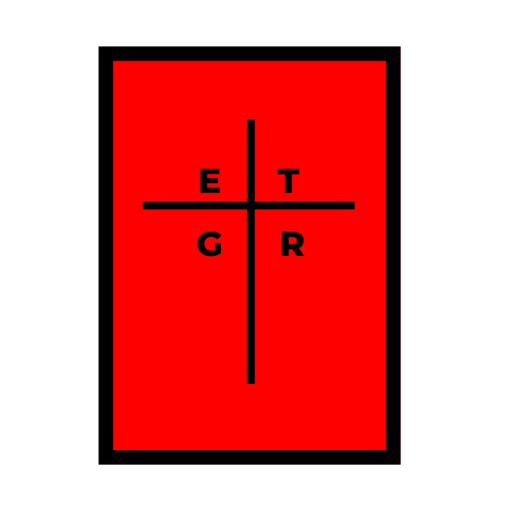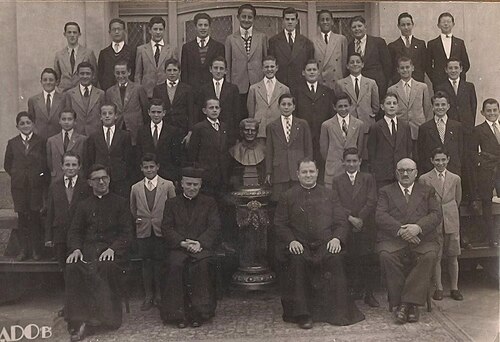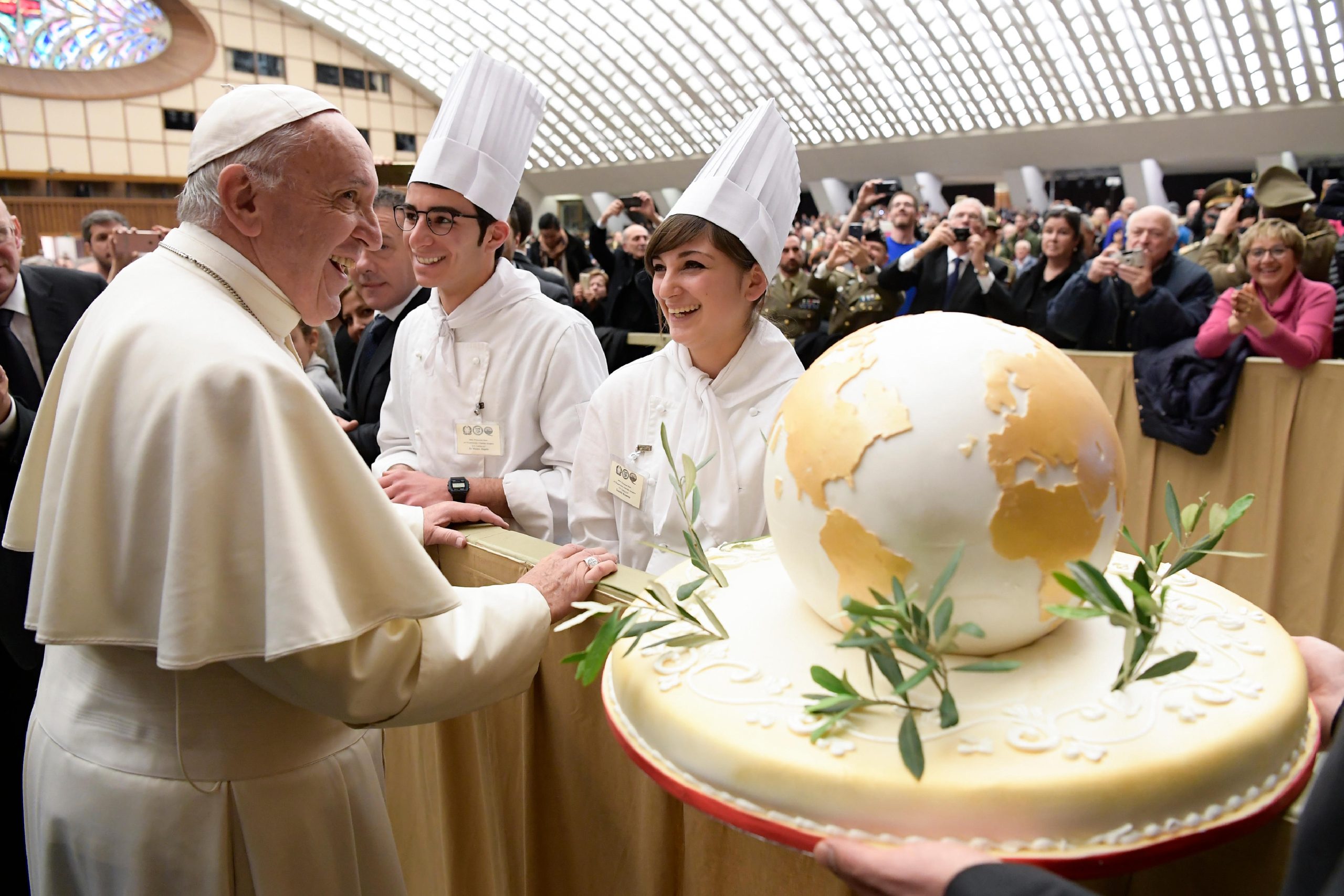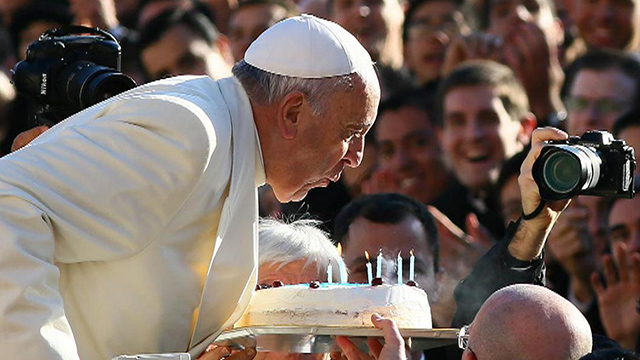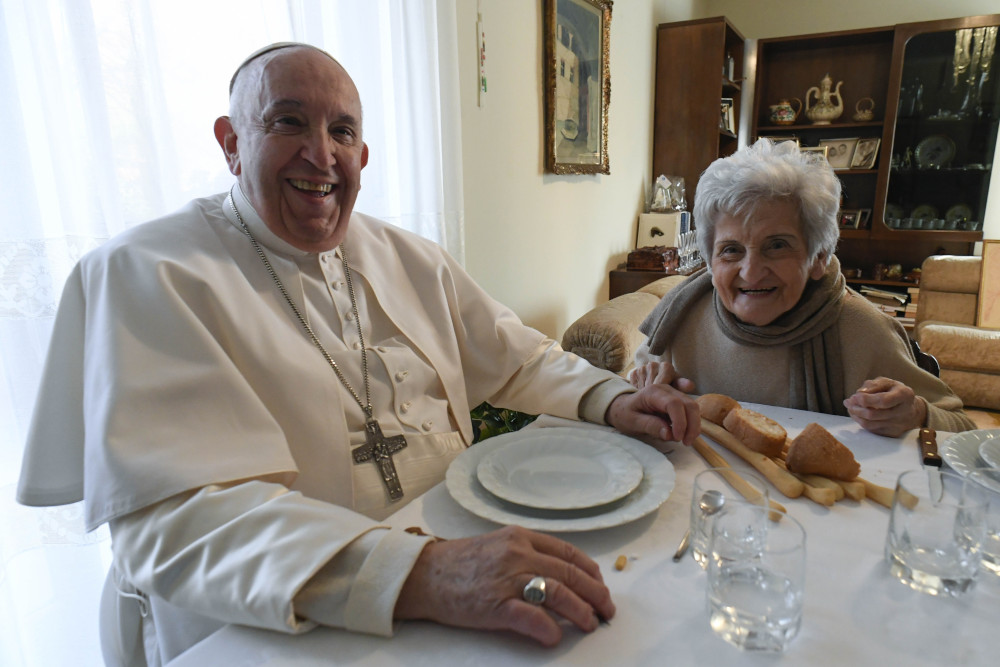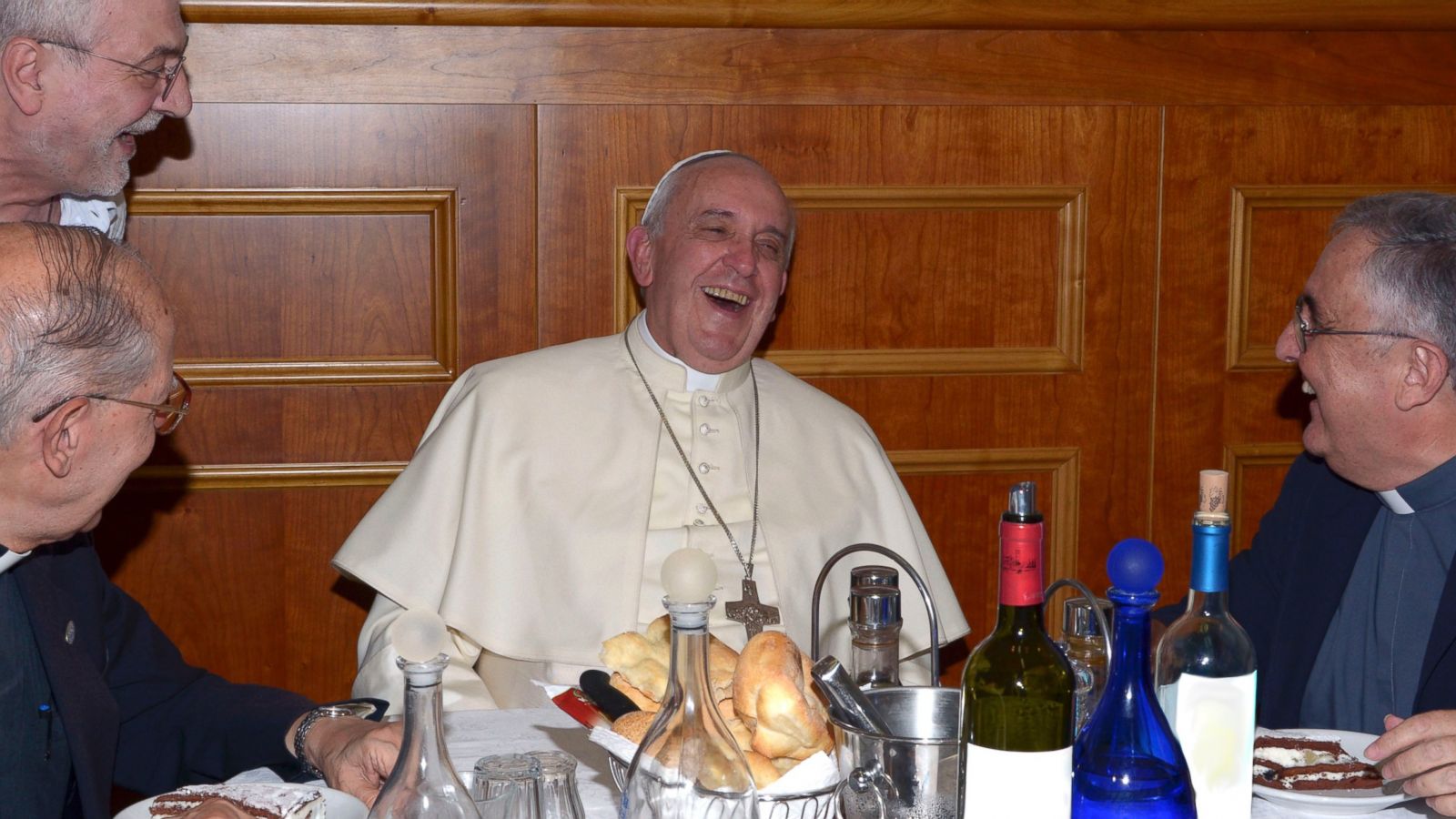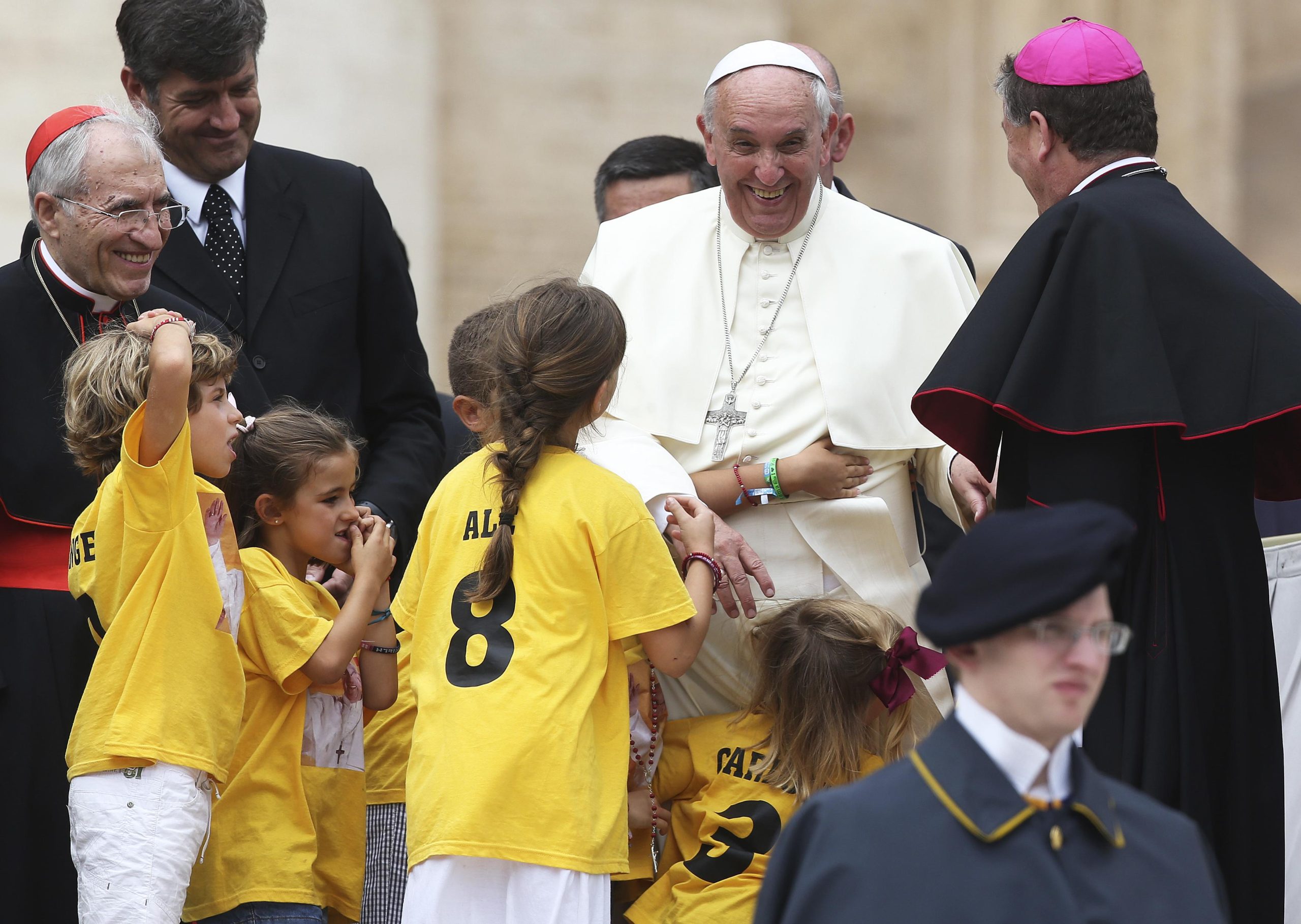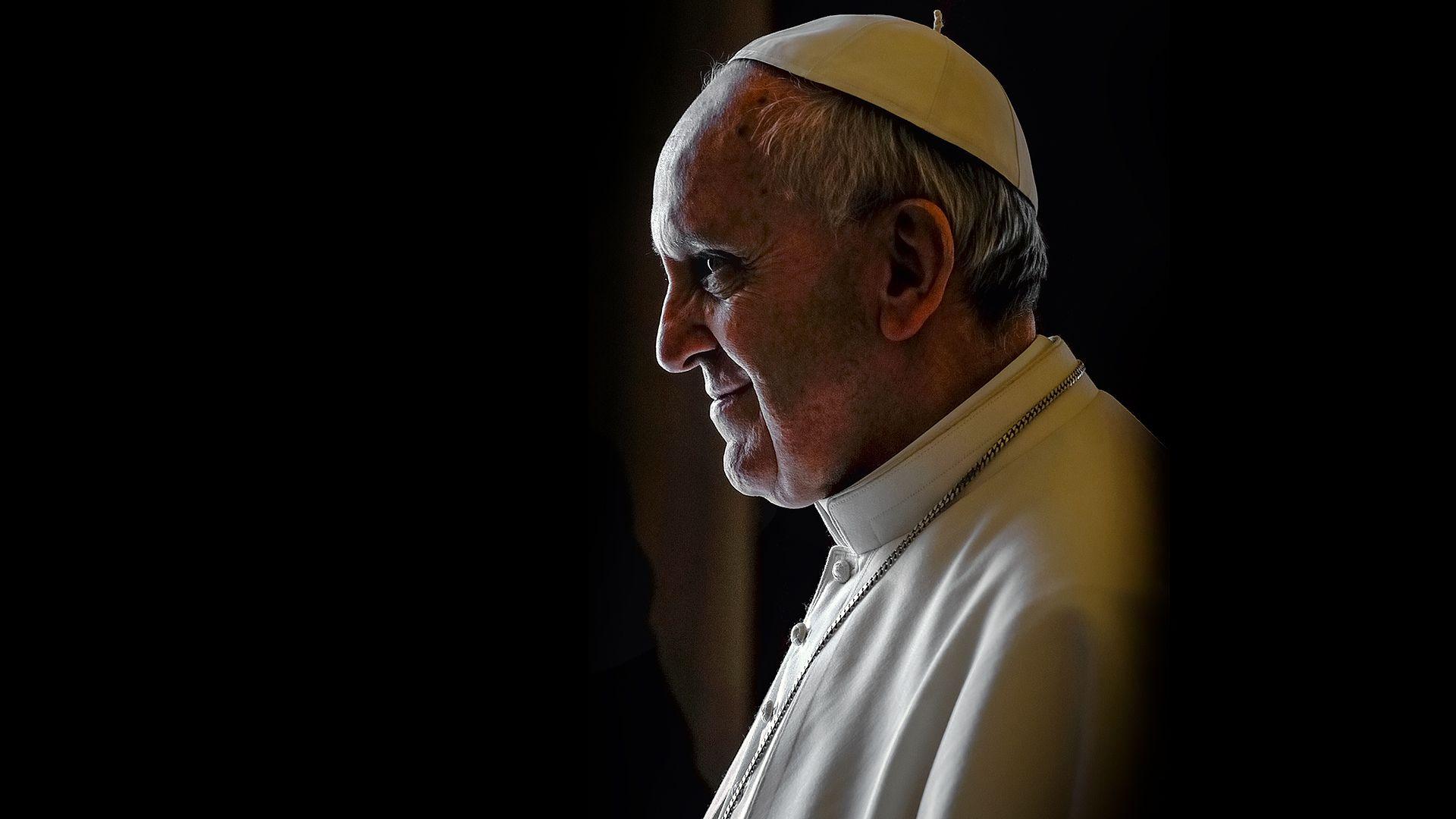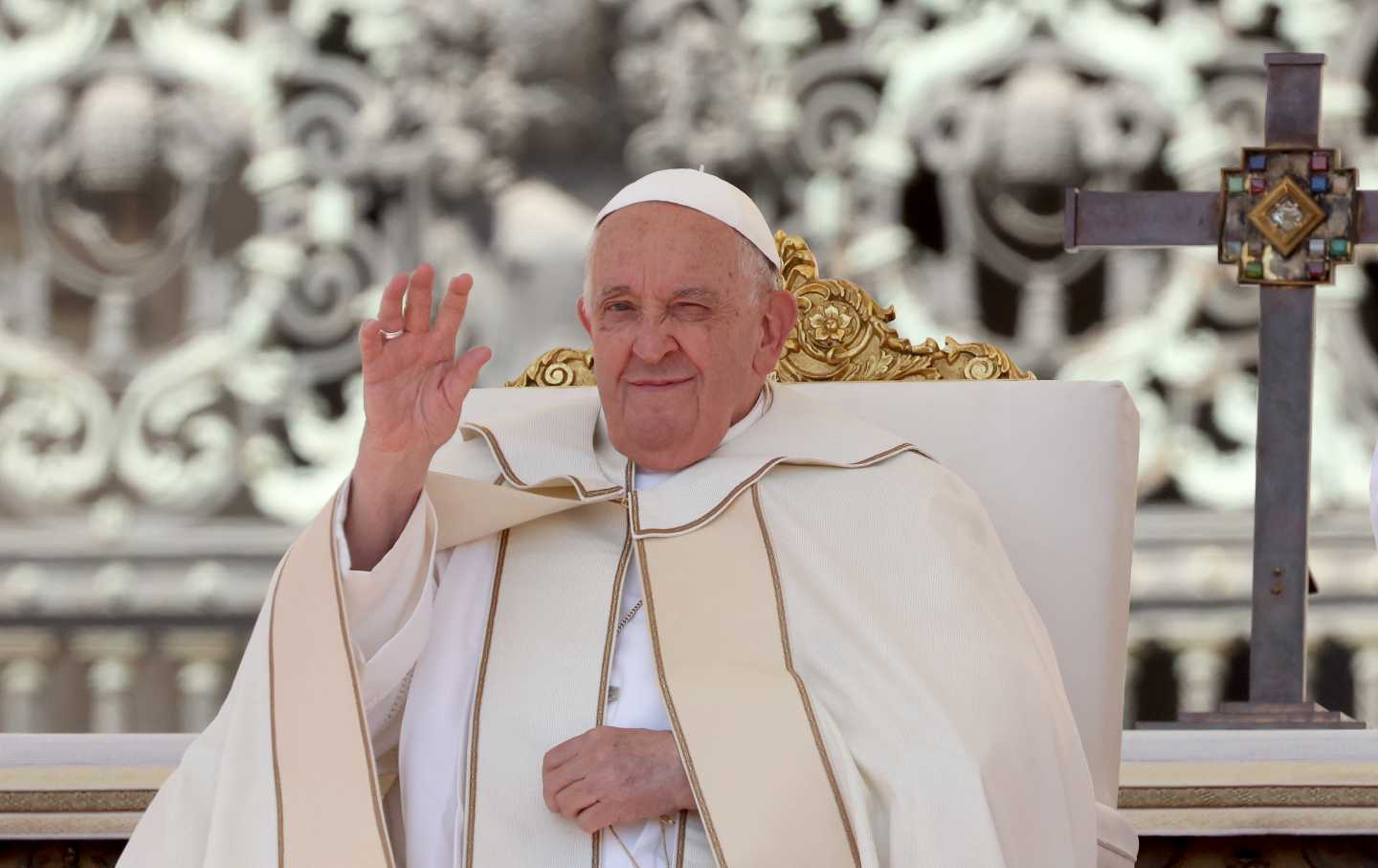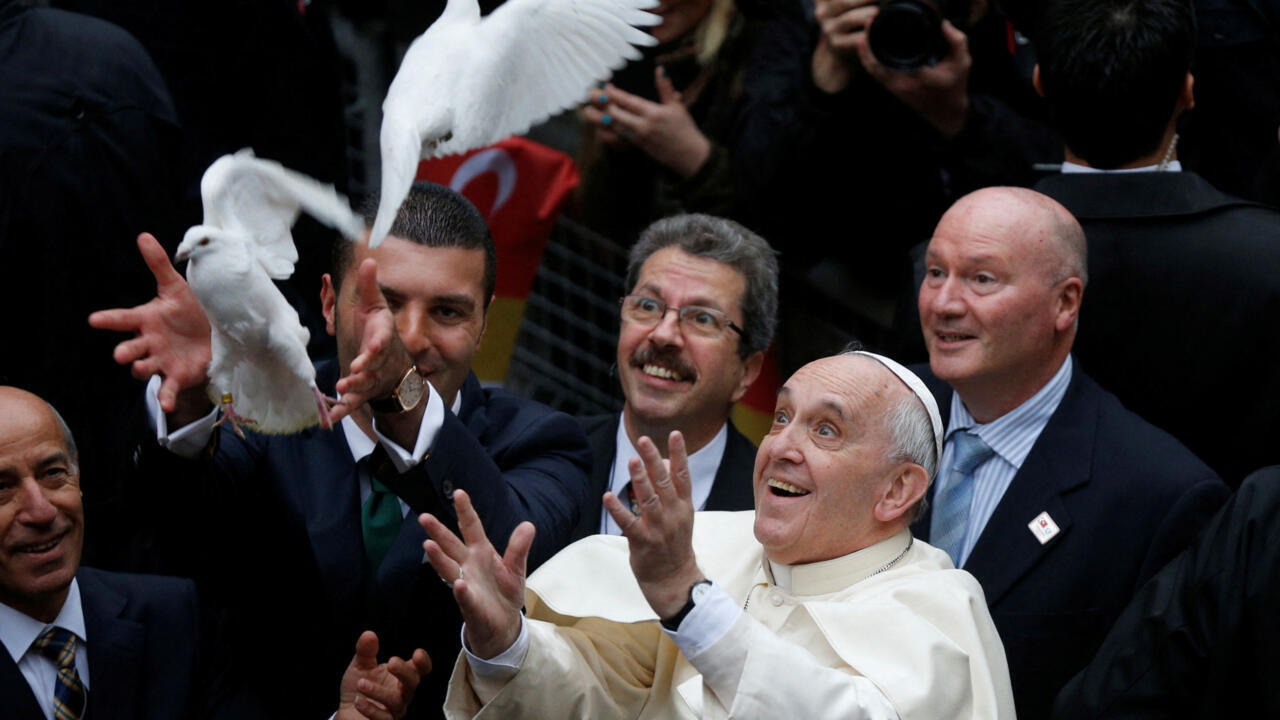Pope Francis (born Jorge Mario Bergoglio) was the head of the Catholic Church and sovereign of the Vatican City State from 13 March 2013 until his death in 2025. He was the first Jesuit pope, the first Latin American, and the first born or raised outside Europe since the 8th-century Syrian pope Gregory III.
Born in Buenos Aires, Argentina, to a family of Italian origin, Bergoglio was inspired to join the Jesuits in 1958 after recovering from a severe illness. He was ordained a Catholic priest in 1969, and from 1973 to 1979 he was the Jesuit provincial superior in Argentina. He became the archbishop of Buenos Aires in 1998 and was created a cardinal in 2001 by Pope John Paul II. Following the resignation of Pope Benedict XVI on 28 February 2013, a papal conclave elected Bergoglio as his successor on 13 March. He chose Francis as his papal name in honor of Saint Francis of Assisi.
Throughout his papacy, Francis was noted for his humility, emphasis on God’s mercy, international visibility, commitment to interreligious dialogue, and concern for the poor, migrants, and refugees. Francis believed the Catholic Church should demonstrate more inclusivity to LGBTQ people, and stated that although blessings of same-sex unions are not permitted, individuals in same-sex relationships can be blessed as long as the blessing is not given in a liturgical context. Francis made women full members of dicasteries in the Roman Curia. Francis convened the Synod on Synodality, which was described as the culmination of his papacy and the most important event in the Catholic Church since the Second Vatican Council. Francis was known for having a less formal approach to the papacy than his predecessors by, for instance, choosing to reside in the Domus Sanctae Marthae guesthouse rather than in the papal apartments of the Apostolic Palace used by previous popes. In addition, due to both his Jesuit and Ignatian aesthetic, he was known for favoring simpler vestments devoid of ornamentation, including refusing the traditional papal mozzetta cape upon his election, choosing silver instead of gold for his piscatory ring, and keeping the same pectoral cross he had as cardinal.
Concerning global governance, Francis was a critic of trickle-down economics, consumerism, and overdevelopment; he made action on climate change a leading focus of his papacy. He viewed capital punishment as inadmissible in all cases, and committed the Catholic Church to its worldwide abolition. Francis criticized the rise of right-wing populism and anti-immigration politics, calling the protection of migrants a “duty of civilization”. Francis supported the decriminalization of homosexuality. In international diplomacy, Francis helped to restore full diplomatic relations between Cuba and the United States, negotiated a deal with the People’s Republic of China to define Communist Party influence in appointing Chinese bishops, and encouraged peace between Israel and Palestinians, signing the Vatican’s first treaty with the State of Palestine. In 2022 he apologized for the Church’s role in the cultural genocide of Canadian Indigenous peoples in residential schools. From 2023 he condemned Israel’s military operations in Gaza, calling for investigations of war crimes. Francis made his last public appearance on Easter Sunday before dying on 21 April 2025, Easter Monday. The 2025 papal conclave elected Leo XIV as Francis’s successor on 8 May. Leo XIV became the second Pope from the Americas, after Francis.
Pope Francis was born Jorge Mario Bergoglio on 17 December 1936 in Flores, a neighbourhood of Buenos Aires. He was the eldest of the five children of Mario José Bergoglio and Regina María Sívori. Mario Bergoglio was an Italian immigrant and an accountant from Piedmont. Regina Sívori was a housewife born in Buenos Aires to a family of northern Italian origin. Mario Bergoglio’s family left Italy in 1929 to escape the fascist rule of Benito Mussolini. According to María Elena Bergoglio, the Pope’s only living sibling, the family did not emigrate for economic reasons. His other siblings were Oscar Adrián, Marta Regina, and Alberto Horacio. His niece, Cristina Bergoglio, is a painter based in Madrid, Spain.
In the sixth grade, Bergoglio attended Wilfrid Barón de los Santos Ángeles, a school of the Salesians of Don Bosco in Ramos Mejía, Buenos Aires Province. He then attended the technical secondary school Escuela Técnica Industrial Nº 27 Hipólito Yrigoyen and graduated with a chemical technician’s diploma. In that capacity, he spent several years working in the food section of Hickethier-Bachmann Laboratory where he worked under Esther Ballestrino. Earlier, he had been a bouncer and a janitor.
When he was 21 years old, after life-threatening pneumonia and three cysts, Bergoglio had part of a lung excised.
Training and early priesthood (1958–1973)
While on his way to celebrate the Spring Day, Bergoglio passed by a church to go to confession and was inspired by a priest. He then studied at the archdiocesan seminary, Inmaculada Concepción Seminary, in Villa Devoto, Buenos Aires, and, after three years, entered the Society of Jesus as a novice on 11 March 1958. Bergoglio said that, as a young seminarian, he had a crush on a girl and briefly doubted his religious career. As a Jesuit novice, he studied the humanities in Santiago, Chile.
After his novitiate, Bergoglio officially became a Jesuit on 12 March 1960 when he made the religious profession of the initial, perpetual vows of poverty, chastity and obedience of a member of the order. In 1960, Bergoglio obtained a licentiate in philosophy from the Colegio Máximo de San José. He then taught literature and psychology at the Colegio de la Inmaculada Concepción, a high school in Santa Fe, from 1964 to 1965. In 1966, he taught the same courses at the Colegio del Salvador in Buenos Aires. In 1967, Bergoglio began his theological studies at Facultades de Filosofía y Teología de San Miguel. On 13 December 1969, he was ordained as a priest by Archbishop Ramón José Castellano. He served as the master of novices for the province there and became a professor of theology.
Bergoglio completed his final stage of spiritual training as a Jesuit, tertianship, at Alcalá de Henares, Spain, and took final vows as a Jesuit, including the fourth vow of obedience to missioning by the pope, on 22 April 1973.
Subsequent positions (1973–1986)
He was named provincial superior of the Society of Jesus in Argentina that July for a six-year term which ended in 1979. In 1973, he made a pilgrimage to Jerusalem, but his stay was shortened by the outbreak of the Yom Kippur War.
After the completion of his term of office, he was named, in 1980, the rector of the Philosophical and Theological Faculty of San Miguel where he had studied. Before taking up this new appointment, he spent the first three months of 1980 in Ireland to learn English and stayed at the Jesuit Centre at the Milltown Institute of Theology and Philosophy, Dublin. He then served at San Miguel for six years until 1986 when, at the discretion of Jesuit superior-general Peter Hans Kolvenbach, he was replaced by someone more in tune with the worldwide trend in the Society of Jesus toward emphasizing social justice rather than his emphasis on popular religiosity and direct pastoral work.
Bergoglio then spent several months at the Sankt Georgen Graduate School of Philosophy and Theology in Frankfurt, Germany, and considered possible dissertation topics. He settled on exploring the work of the German-Italian theologian Romano Guardini, particularly his study of “Contrast” published in his 1925 work Der Gegensatz.
Return to Argentina (1986–1998)
Ultimately, however, Bergoglio did not complete a degree there and he returned to Argentina earlier than expected to serve as a confessor and spiritual director to the Jesuit community in Córdoba. As a student at the Salesian school, Bergoglio was mentored by Ukrainian Greek Catholic priest Stefan Czmil. Bergoglio often rose hours before his classmates to serve Divine Liturgy for Czmil.
Bergoglio was named Auxiliary Bishop of Buenos Aires in 1992 and was consecrated on 27 June 1992 as titular bishop of Auca, with Cardinal Antonio Quarracino, archbishop of Buenos Aires, serving as principal consecrator. He chose his episcopal motto to be Miserando atque eligendo, drawn from Saint Bede’s homily on Matthew 9:9–13: “because he saw him through the eyes of mercy and chose him”. In 1992, Jesuit authorities asked Bergoglio not to live in Jesuit residences due to ongoing tensions with leaders and scholars; concerns about his “dissent”, views on Catholic orthodoxy, and opposition to liberation theology; and his role as auxiliary bishop of Buenos Aires.
On 3 June 1997, Bergoglio was appointed coadjutor archbishop of Buenos Aires.
Archbishop of Buenos Aires (1998–2013)
He became metropolitan archbishop after Quarracino’s death on 28 February 1998. As archbishop, he established new parishes, restructured the archdiocese, led pro-life efforts, and formed a commission on divorces. One of Bergoglio’s major initiatives as archbishop was to increase the church’s presence in the shantytown (villa miseria, or just villa) slums of Buenos Aires. Under his leadership, the number of priests assigned to work in the shantytowns doubled, and he visited them himself. This work led to him being referred to as the “villero bishop”, sometimes translated as the “slum bishop”.
Early in his tenure as archbishop, Bergoglio sold the archdiocese’s bank shares and moved its accounts to regular international banks. This ended the church’s high spending habits, which had nearly led to bankruptcy, and enforced stricter fiscal discipline. On 6 November 1998, while remaining archbishop of Buenos Aires, Bergoglio was named Ordinary for Eastern Catholics in Argentina, who lacked a prelate of their own church. On Bergoglio’s election to the papacy, Major Archbishop Sviatoslav Shevchuk said that Bergoglio understood the liturgy, rites, and spirituality of Shevchuk’s Ukrainian Greek Catholic Church and always “took care of our Church in Argentina” as Ordinary.
In 2000, Bergoglio was the only church official to reconcile with Jerónimo Podestá, a former bishop who had been suspended as a priest after opposing the Argentine Revolution military dictatorship in 1972. He also defended Podestá’s wife from Vatican attacks on their marriage. That same year, Bergoglio said the Argentine Catholic Church needed “to put on garments of public penance for the sins committed during the years of the dictatorship” in the 1970s, during the Dirty War.
Bergoglio regularly celebrated the Holy Thursday foot-washing ritual in jails, hospitals, retirement homes, and slums. Bergoglio continued to be the archbishop of Buenos Aires after his elevation to the cardinalate in 2001. In 2007, shortly after Benedict XVI introduced new rules for pre–Vatican II liturgical forms, Bergoglio established a weekly Mass in this extraordinary form of the Roman Rite.
On 8 November 2005, Bergoglio was elected president of the Argentine Episcopal Conference for a three-year term (2005–2008), and re-elected on 11 November 2008. He remained a member of that commission’s permanent governing body, the president of its committee for the Pontifical Catholic University of Argentina, and a member of its liturgy committee for the care of shrines. While head of the Argentine Catholic bishops’ conference, Bergoglio issued a collective apology for his church’s failure to protect people from the junta during the Dirty War. When he turned 75 in December 2011, Bergoglio submitted his resignation as archbishop of Buenos Aires to Pope Benedict XVI as required by canon law. As he had no coadjutor archbishop, he stayed in office, waiting for the Vatican to appoint a replacement.
As a bishop, he was no longer subject to his Jesuit superior. From then on, he no longer visited Jesuit houses and was in “virtual estrangement from the Jesuits” until after his election as pope.
Appointment as cardinal
On 21 February 2001, Pope John Paul II made Archbishop Bergoglio a cardinal, assigning him the title of cardinal priest of San Roberto Bellarmino. Bergoglio was installed there on 14 October. During his trip to Rome for the ceremony, he and his sister María Elena visited their father’s hometown in northern Italy. As cardinal, Bergoglio was appointed to five administrative positions in the Roman Curia. He was a member of the Congregation for Divine Worship and the Discipline of the Sacraments; the Congregation for the Clergy; the Congregation for Institutes of Consecrated Life and Societies of Apostolic Life; the Pontifical Council for the Family; and the Commission for Latin America. Later that year, when Cardinal Edward Egan returned to New York following the September 11 attacks, Bergoglio replaced him as relator (recording secretary) in the Synod of Bishops, and, according to the Catholic Herald, created “a favourable impression as a man open to communion and dialogue”
Cardinal Bergoglio was known for his personal humility, doctrinal conservatism, and commitment to social justice. His simple lifestyle—which included living in a small apartment rather than the elegant bishop’s residence, using public transportation, and cooking his own meals—enhanced his reputation for humility. He limited his time in Rome to “lightning visits”.
After Pope John Paul II died on 2 April 2005, Bergoglio attended his funeral and was considered one of the papabile for succession to the papacy. He participated as a cardinal elector in the 2005 papal conclave that elected Pope Benedict XVI. In the National Catholic Reporter, John L. Allen Jr. reported that Bergoglio was a frontrunner in the 2005 conclave. In September 2005, the Italian magazine Limes published claims that Bergoglio had been the runner-up and main challenger to Cardinal Ratzinger at that conclave and that he had received 40 votes in the third ballot but fell back to 26 at the fourth and decisive ballot. The claims were based on a diary purportedly belonging to an anonymous cardinal who had been present at the conclave. According to the Italian journalist Andrea Tornielli, this number of votes had no precedent for a Latin American papabile. La Stampa reported that Bergoglio was in close contention with Ratzinger during the election until he made an emotional plea that the cardinals should not vote for him. According to Tornielli, Bergoglio made this request to prevent the conclave from delaying too much in the election of a pope.
As a cardinal, Bergoglio was associated with Communion and Liberation, a Catholic evangelical lay movement of the type known as associations of the faithful. He sometimes made appearances at the annual gathering known as the Rimini Meeting held during the late summer months in Italy. In 2005, Cardinal Bergoglio authorized the request for beatification—the third of four steps toward sainthood—for six members of the Pallottine community murdered in the San Patricio Church massacre. Bergoglio also ordered an investigation into the murders; 1984 testimony indicated that they were perpetrated by members of the Argentine Navy on the orders of Rear Admiral Rubén Chamorro.
Argentine government relations
Dirty War
Bergoglio was the subject of allegations regarding the Argentine Navy’s kidnapping of two Jesuit priests, Orlando Yorio and Franz Jalics, in 1976, during Argentina’s Dirty War. After being tortured in captivity, the priests were found alive months later outside Buenos Aires, drugged and partially unclothed. Bergoglio is widely reported to have failed to protect the priests, and to have dismissed them from the Society of Jesus days prior to their arrest. In 2005, Myriam Bregman, a human rights lawyer, filed a criminal complaint against Bergoglio, as superior in the Society of Jesus of Argentina, accusing him of actual involvement in the kidnapping. While the complaint was eventually dismissed, the debate over Bergoglio’s actions during the period has continued, with Argentine journalists relying on documents and statements from both priests and laypeople in reporting that contradict Cardinal Bergoglio’s account.
Yorio accused Bergoglio of effectively handing them over to the death squads by declining to tell the authorities that he endorsed their work. Yorio said in a 1999 interview that he believed that Bergoglio did nothing “to free us, in fact just the opposite”. Two days after the election of Francis, Jalics issued a statement confirming the kidnapping and attributing the cause to a former lay colleague who became a guerrilla, was captured, then named Yorio and Jalics when interrogated. The following week, Jalics issued a second, clarifying statement: “It is wrong to assert that our capture took place at the initiative of Father Bergoglio … Orlando Yorio and I were not denounced by Father Bergoglio.”
Bergoglio told his authorized biographer, Sergio Rubin, that he worked behind the scenes for the priests’ release; Bergoglio’s intercession with dictator Jorge Rafael Videla on their behalf may have saved their lives. Bergoglio also told Rubin that he had often sheltered people from the dictatorship on church property, and once gave his own identity papers to a man who looked like him so that he could flee Argentina. The interview with Rubin, reflected in the biography El jesuita, was the only time Bergoglio had spoken to the press about those events. Alicia Oliveira, a former Argentine judge, also reported that Bergoglio helped people flee Argentina during the rule of the junta. Since Francis became pope, Gonzalo Mosca and José Caravias have related accounts to journalists of how Bergoglio helped them flee the dictatorship.
Oliveira described Bergoglio as “anguished” and “very critical of the dictatorship” during the Dirty War. Oliveira met with him at the time and urged Bergoglio to speak out—he told her that “he couldn’t. That it wasn’t an easy thing to do.”Artist and human rights activist Adolfo Pérez Esquivel, the 1980 Nobel Peace Prize laureate, said: “Perhaps he didn’t have the courage of other priests, but he never collaborated with the dictatorship… Bergoglio was no accomplice of the dictatorship.” Graciela Fernández Meijide, a member of the Permanent Assembly for Human Rights, also said that there was no proof linking Bergoglio with the dictatorship. She told the Clarín newspaper:
There is no information and Justice couldn’t prove it. I was in the APDH during all the dictatorship years and I received hundreds of testimonies. Bergoglio was never mentioned. It was the same in the CONADEP. Nobody mentioned him as instigator or as anything.
Ricardo Lorenzetti, the president of the Argentine Supreme Court, said that Bergoglio was “completely innocent” of the accusations. Historian Uki Goñi pointed that, during early 1976, the military junta still had a good image among society, and that the scale of the political repression was not known until much later; Bergoglio would have had little reason to suspect that the detention of Yorio and Jalics could end in their deaths.
Fernando de la Rúa
Fernando de la Rúa replaced Carlos Menem as president of Argentina in 1999. As an archbishop, Bergoglio celebrated the annual Mass at the Buenos Aires Metropolitan Cathedral on the First National Government holiday, 25 May. During Argentina’s economic depression, the Catholic Church criticized the government’s austerity measures, which worsened poverty. De la Rúa asked the church to facilitate dialogue between economic and political leaders to address the crisis. Although he claimed to have spoken with Bergoglio, Bergoglio reportedly said the meeting was canceled due to a misunderstanding. Bishop Jorge Casaretto had doubted this, noting that De la Rúa made the request only in newspaper interviews, not formally to the church.
In the 2001 elections, the Justicialist Party won a majority in Congress and appointed Ramón Puerta as Senate president. Bergoglio met with Puerta and was positively impressed. Puerta assured him that the Justicialist Party was not planning to oust De la Rúa and promised to support the president in advancing necessary legislation.
During police repression of the riots of December 2001, Bergoglio contacted the Ministry of the Interior and asked that the police distinguish rioters and vandals from peaceful protesters.
Néstor and Cristina Kirchner
When Bergoglio celebrated Mass at the cathedral for the 2004 First National Government holiday, President Néstor Kirchner attended and heard Bergoglio request more political dialogue, the rejection of intolerance, and the criticism of exhibitionism and strident announcements. Kirchner celebrated the national day elsewhere the following year and the Mass in the cathedral was suspended. In 2006, Bergoglio helped fellow Jesuit Joaquín Piña win the elections in the Misiones Province and prevent an amendment to the local constitution that would allow indefinite re-elections. Kirchner intended to use that project to start similar amendments at other provinces and eventually implement it in the national constitution. Kirchner considered Bergoglio as a political rival until he died in 2010. Bergoglio’s relations with Kirchner’s widow and successor, Cristina Fernández de Kirchner, have been similarly tense. In 2008, Bergoglio called for national reconciliation during disturbances in the country’s agricultural regions, which the government interpreted as a support for anti-government demonstrators. The campaign to enact same-sex marriage legislation was a particularly tense period in their relations.
When Bergoglio was elected pope, initial reactions were mixed. Most of the Argentine society cheered it, but the pro-government newspaper Página 12 published renewed allegations about the Dirty War, and the president of the National Library described a global conspiracy theory. The president took more than an hour before congratulating the new pope and did so only in a passing reference within a routine speech. Due to the Pope’s popularity in Argentina, Cristina Kirchner made what the political analyst Claudio Fantini called a “Copernican shift” in her relations with him and fully embraced the Francis phenomenon. On the day before his inauguration as pope, Bergoglio, now Francis, had a private meeting with Kirchner where they exchanged gifts and lunched together. This was the new pope’s first meeting with a head of state, and there was speculation that the two were mending their relations. Página 12 then removed their controversial articles about Bergoglio from their web page as a result of this change.
Javier Milei
Before Javier Milei’s election to the Argentine presidency in 2023, he was very critical of Francis, describing him as “imbecile” and a “communist turd”. His disparaging comments sparked controversy among Catholics. However, following his inauguration, Milei softened his position and formally invited Francis to Argentina. Milei visited the Vatican on 11 February 2024, the day Francis canonized María Antonia de Paz y Figueroa, the first female Argentine saint.
Papacy (2013–2025)
Francis was the first Jesuit pope. This was a significant appointment because of the sometimes tense relations between the Society of Jesus and the Holy See. He was also the first from the Americas, and the first from the Southern Hemisphere. Many media reported him as being the first non-European pope, but he was the 11th; the previous was Gregory III from Syria who died in 741. Although Francis was not born in Europe, he was ethnically European; his father and maternal grandparents were from northern Italy.
As pope, Francis’s manner was less formal than that of his immediate predecessors, a style that news coverage referred to as “no frills”, noting that it was “his common touch and accessibility that is proving the greatest inspiration”. On the night of his election, he took a bus back to his hotel with the cardinals rather than being driven in the papal car. The next day, he visited Cardinal Jorge María Mejía in the hospital and chatted with patients and staff.
In addition to his native Spanish, he spoke fluent Italian (the official language of Vatican City and the “everyday language” of the Holy See) and German. He was also conversant in Latin (the official language of the Holy See), French, Portuguese, and English; he also understood Piedmontese and some Genoese Ligurian.
Francis chose not to live in the official papal residence in the Apostolic Palace but instead remained in the Vatican guest house in a suite in which he received visitors and held meetings. He was the first pope since Pope Pius X to live outside the papal apartments. Francis appeared at the window of the Apostolic Palace for the Sunday Angelus.
As a Jesuit pope, Francis made clear that a fundamental task of the faithful is not so much to follow rules but to discern what God is calling them to do. He altered the culture of the clergy, steering away from what he named “clericalism” (which dwells on priestly status and authority) and toward an ethic of service (Francis said the church’s shepherds must have the “smell of the sheep”, always staying close to the People of God).
Election
Bergoglio was elected pope on 13 March 2013, the second day of the 2013 papal conclave, after which he took the papal name Francis. Francis was elected on the fifth ballot. The Habemus papam announcement was delivered by the cardinal protodeacon, Jean-Louis Tauran. Cardinal Christoph Schönborn later said that Bergoglio was elected following two supernatural signs, one in the conclave—and hence confidential—and one from a Latin-American couple, friends of Schönborn at Vatican City, who whispered Bergoglio’s name in the elector’s ear; Schönborn commented “if these people say Bergoglio, that’s an indication of the Holy Spirit”.
Instead of accepting his cardinals’ congratulations while seated on the papal throne, Francis received them standing, reportedly an immediate sign of a changing approach to formalities at the Vatican. During his first appearance as pontiff on the balcony of Saint Peter’s Basilica, he wore a white cassock, instead of the red, ermine-trimmed mozzetta used by previous popes. He also wore the same iron pectoral cross that he had worn as archbishop of Buenos Aires, rather than the gold one worn by his predecessors.
After being elected and choosing his name, his first act was bestowing the Urbi et Orbi blessing on thousands of pilgrims gathered in St. Peter’s Square. Before blessing the crowd, he delivered a brief speech, greeting those in St. Peter’s Square with a simple “Buonasera” (“Good evening”, in Italian). He thanked the crowd for welcoming him and asked them to pray for his predecessor, “the bishop emeritus of Rome” Pope Benedict XVI, and for himself as the new “bishop of Rome”. He also referred to himself as a Pope coming almost from the end of the world.
Francis held his papal inauguration on 19 March 2013 in St. Peter’s Square. He celebrated Mass in the presence of political and religious leaders from around the world. In his homily, Francis focused on the Solemnity of Saint Joseph, the liturgical day on which the Mass was celebrated.
The next day, Federico Lombardi told to the media that Francis had met all the cardinals in the Sistine Chapel choosing to stand up, rather than sitting on the chair at his disposal, and that he went back to the Domus Sanctae Marthae on a minivan with the other cardinals, instead of using a private car. Afterward he went to the guest house where he had resided during the conclave, collected his belongings and insisted on paying the bill.
At his first audience on 16 March 2013, Francis told journalists that he had chosen the name in honor of Saint Francis of Assisi and had done so because he was especially concerned for the well-being of the poor. He explained that, as it was becoming clear during the conclave voting that he would be elected, the Brazilian Cardinal Cláudio Hummes had embraced him and whispered, “Don’t forget the poor”, which made Bergoglio think of the saint. Bergoglio had previously expressed his admiration for St. Francis, explaining that: “He brought to Christianity an idea of poverty against the luxury, pride, vanity of the civil and ecclesiastical powers of the time. He changed history.”
It was the first time that a pope had been named “Francis”. On the day of his election, the Vatican clarified that his official papal name was “Francis” and not “Francis I”; that is, no regnal number was used for him. If there is a Francis II, then Francis will be known as Francis I. It was the first time since Lando’s 913–914 pontificate that a canonical pope held a name not used by a predecessor.
Francis also said that some cardinal electors had jokingly suggested to him that he should choose either “Adrian”, since Adrian VI had been a reformer of the church, or “Clement”, to settle the score with Clement XIV who had suppressed the Jesuit order. Bergoglio, had he been elected in 2005, would have chosen the pontifical name of “John XXIV” in honor of John XXIII. He told Cardinal Francesco Marchisano: “John, I would have called myself John, like the Good Pope; I would have been completely inspired by him.
Francis abolished the bonuses paid to Vatican employees upon the election of a new pope, amounting to several million euros, opting instead to donate the money to charity. He also abolished the €25,000 annual bonus paid to cardinals serving on the Board of Supervisors for the Vatican bank.
On 13 April 2013, Francis named eight cardinals to a new Council of Cardinal Advisers to advise him on revising the organizational structure of the Roman Curia. The group included several known critics of Vatican operations and only one member of the Curia.
Francis’s last public appearance was at St. Peter’s Square in Vatican City on Easter Sunday, 20 April 2025, where he gave his final Easter address and called for a ceasefire in Gaza. He died at 07:35 local time (UTC+02:00) on Easter Monday, 21 April 2025, aged 88, in his residence in Domus Sanctae Marthae. His death, announced by Cardinal Kevin Farrell on the Vatican’s TV channel and in a video statement, was caused by a cerebral stroke, which led to a coma and irreversible cardiac arrest.
The pope’s death began a papal interregnum and a nine-day period of mourning known as the novendiales (Latin for ‘nine days’). His funeral took place on 26 April 2025. Cardinal electors arrived in Rome to attend the congregation of cardinals and decided that 7 May 2025 shall be the start of the conclave set to elect Francis’s successor. On 8 May, Robert Francis Prevost, who was made a cardinal by Francis in 2023, was elected as Pope Leo XIV.
Francis’s spiritual testament, dated 29 June 2022, repeated his wish to be buried at the Basilica of Santa Maria Maggiore in Rome. Upon his death, he was laid to rest there in accordance with his testament, becoming the first pope to be interred in the Santa Maria Maggiore since Clement IX in 1669. His testament ended:
May the Lord grant a fitting reward to all those who have loved me and who continue to pray for me. The suffering that has marked the final part of my life, I offer to the Lord, for peace in the world and for fraternity among peoples.
Legacy
Francis’s papacy coincided with a period of widespread change and reckoning within the global Catholic order and within society at large. Throughout his papacy, he was noted for his support for the plight of refugees, migrants, and the impoverished. Since their beginnings, he had been outspoken in his criticism of the wars in Ukraine, Sudan, Gaza, DR Congo, and Myanmar, notwithstanding numerous other conflicts and acts of suppression against the civilian population globally. He appointed more than 80% of the cardinals that elected his successor, notably reducing the European share of the College of Cardinals from a majority to a plurality. He was celebrated for his outreach to China and the African continent, his tolerance towards differing faith communities, and his attention to younger Catholic adherents and the changing nature of the faith. He formalized the church’s policy of opposition to the death penalty in all cases.
Under his papacy, women remained banned from becoming priests, joining the Diaconate, or being appointed to the College of Bishops or Cardinals. However, Francis made significant strides towards increasing women’s presence in the senior and central administration of the church. He was the first to grant them voting rights within the Synod of Bishops, and increased their presence in functions and institutions of the Church that had previously been restricted to or dominated by men. He has nonetheless been criticized by some as having only produced reform within existing frameworks of gender division within the Catholic Church, doing little to advance serious, radical reform of its institutions to ensure an ideal of inclusion and parity.
He set himself apart from other Popes in upholding the Church’s departure from the Tridentine mass, which had only been loosely enforced by both predecessors whose reign occurred after the institution of the reforms of the Second Vatican Council. Though it was not banned outright during his tenure, he nonetheless greatly increased Vatican oversight over the facilitation of the ritual, and restricted the right of new priests to engage in the practice. Some have stated his view as having been that “the Tridentine liturgy [had become] a symbol of the rejection of Vatican II itself as well as of the pope’s teachings.”
In 2022, he issued the first apology by the Vatican for its role in the cultural erasure and forced assimilation of First Nations peoples in Canada from the late 19th to mid-20th centuries. His endorsement of the conditional blessing of same-sex couples earned him praise from many progressive outlets within and outside the Church. Some groups, though, have been critical of the extent of his tolerance on various LGBTQ issues, particularly the question of his acceptance of transgender identity and his answer to the larger issue of homosexuality, queer identity, and sin. The progressive stances he held drew significant criticism from conservative elements within the College.
